[1]:
%matplotlib inline
[2]:
import numpy as np
import numpy.random as rng
import matplotlib.pyplot as plt
import seaborn as sns
import pandas as pd
import pymc3 as pm
import scipy.stats as stats
from sklearn.preprocessing import StandardScaler
import daft
WARNING (theano.configdefaults): install mkl with `conda install mkl-service`: No module named 'mkl'
WARNING (theano.tensor.blas): Using NumPy C-API based implementation for BLAS functions.
[3]:
import theano
import theano.tensor as tt
theano.config.warn.round=False
[4]:
import warnings
warnings.simplefilter('ignore', UserWarning)
[5]:
sns.set_context('notebook')
sns.set_style('darkgrid')
Mixture models¶
We can construct very flexible new distributions using mixtures of other distributions. In fact, we can construct mixtures of not just distributions, but of regression models, neural networks etc, making this a very powerful framework. We consider finite and Dirichlet Process (DP) mixtures, and see basic ideas for how to work with mixtures in pymc3.
The Categorical distribution¶
This is just the extension of the Bernoulli distribuiotn to more than 2 states.
[6]:
cat = stats.multinomial(1, [0.1, 0.2, 0.3, 0.4])
[7]:
cat.rvs(10)
[7]:
array([[0, 0, 1, 0],
[0, 1, 0, 0],
[0, 0, 0, 1],
[0, 0, 0, 1],
[0, 1, 0, 0],
[0, 0, 0, 1],
[0, 0, 1, 0],
[0, 0, 0, 1],
[0, 0, 0, 1],
[1, 0, 0, 0]])
[8]:
x = range(4)
plt.vlines(x, 0, cat.p)
plt.xticks(range(4))
pass

The Dirichlet distribution¶
The code to visualize Dirichlet distributions in barycentric coordinates is from this blog.
[9]:
from functools import reduce
import matplotlib.tri as tri
from math import gamma
from operator import mul
[10]:
corners = np.array([[0, 0], [1, 0], [0.5, 0.75**0.5]])
triangle = tri.Triangulation(corners[:, 0], corners[:, 1])
refiner = tri.UniformTriRefiner(triangle)
trimesh = refiner.refine_triangulation(subdiv=4)
midpoints = [(corners[(i + 1) % 3] + corners[(i + 2) % 3]) / 2.0 \
for i in range(3)]
def xy2bc(xy, tol=1.e-3):
'''Converts 2D Cartesian coordinates to barycentric.'''
s = [(corners[i] - midpoints[i]).dot(xy - midpoints[i]) / 0.75 \
for i in range(3)]
return np.clip(s, tol, 1.0 - tol)
class Dirichlet(object):
def __init__(self, alpha):
self._alpha = np.array(alpha)
self._coef = gamma(np.sum(self._alpha)) / \
reduce(mul, [gamma(a) for a in self._alpha])
def pdf(self, x):
'''Returns pdf value for `x`.'''
return self._coef * reduce(mul, [xx ** (aa - 1)
for (xx, aa)in zip(x, self._alpha)])
def draw_pdf_contours(dist, nlevels=200, subdiv=8, **kwargs):
refiner = tri.UniformTriRefiner(triangle)
trimesh = refiner.refine_triangulation(subdiv=subdiv)
pvals = [dist.pdf(xy2bc(xy)) for xy in zip(trimesh.x, trimesh.y)]
plt.tricontourf(trimesh, pvals, nlevels, **kwargs)
plt.axis('equal')
plt.xlim(0, 1)
plt.ylim(0, 0.75**0.5)
plt.axis('off')
[11]:
ks = (
[0.999, 0.999, 0.999],
[1,1,1],
[5,5,5],
[5,2,1],
)
plt.viridis()
fig = plt.figure(figsize=(12,4))
for i, k in enumerate(ks):
plt.subplot(1,4,i+1)
draw_pdf_contours(Dirichlet(k))
<Figure size 432x288 with 0 Axes>

Samples from Dirichlet distribution¶
[12]:
n = 20
s = stats.dirichlet.rvs(alpha=[7,7,7], size=n).T
[13]:
plt.figure(figsize=(4, n*0.4))
with plt.style.context('seaborn-dark'):
plt.barh(range(n), s[0])
plt.barh(range(n), s[1], left=s[0], color='g')
plt.barh(range(n), s[2], left=s[0]+s[1], color='r')
pass
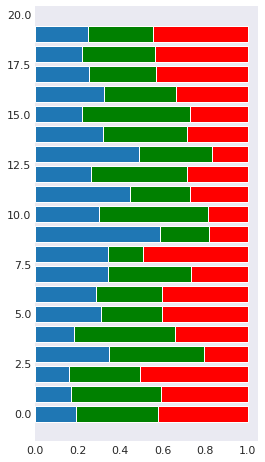
Finite Gaussian Mixture Model¶
Data¶
[14]:
np.random.seed(1)
data = np.r_[np.random.normal(-6, 2, 500),
np.random.normal(0, 1, 200),
np.random.normal(4, 1, 300)]
n = data.shape[0]
[15]:
plt.hist(data, bins=20, normed=True, alpha=0.5)
pass
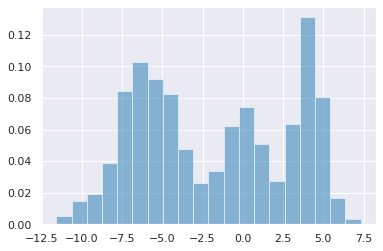
[16]:
data.shape
[16]:
(1000,)
Explicit latent variable¶
[17]:
k = 3
with pm.Model() as gmm1:
p = pm.Dirichlet('p', a=np.ones(k))
z = pm.Categorical('z', p=p, shape=data.shape[0])
μ = pm.Normal('μ', 0, 10, shape=k)
σ = pm.InverseGamma('τ', 1, 1, shape=k)
y = pm.Normal('y', mu=μ[z], sd=σ[z], observed=data)
[18]:
with gmm1:
trace = pm.sample(n_init=10000, tune=1000, random_seed=123)
Multiprocess sampling (4 chains in 4 jobs)
CompoundStep
>NUTS: [τ, μ, p]
>CategoricalGibbsMetropolis: [z]
Sampling 4 chains, 0 divergences: 100%|██████████| 6000/6000 [07:07<00:00, 14.05draws/s]
The rhat statistic is larger than 1.4 for some parameters. The sampler did not converge.
The estimated number of effective samples is smaller than 200 for some parameters.
[19]:
trace.varnames
[19]:
['p_stickbreaking__', 'z', 'μ', 'τ_log__', 'p', 'τ']
[20]:
pm.traceplot(trace, varnames=['p', 'μ', 'τ'])
pass
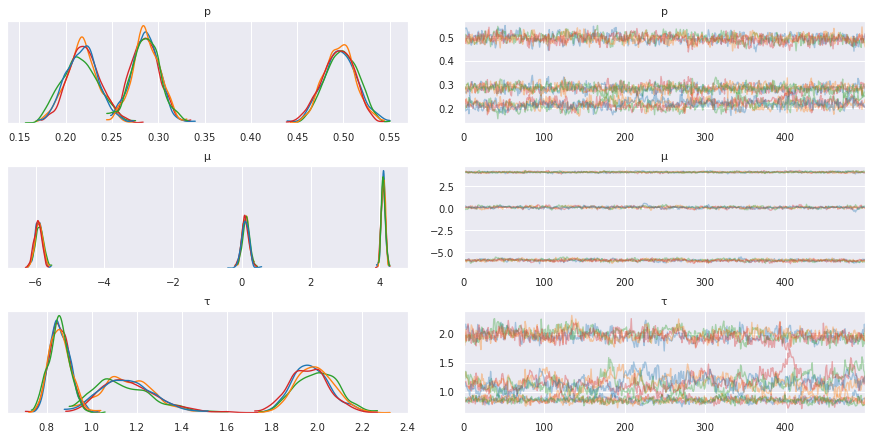
[21]:
with gmm1:
ppc = pm.sample_posterior_predictive(trace, samples=10)
plt.hist(data, bins=20, normed=True, alpha=0.5)
for i in range(10):
sns.distplot(ppc['y'][i], hist=False, color='grey')
100%|██████████| 10/10 [00:00<00:00, 105.97it/s]
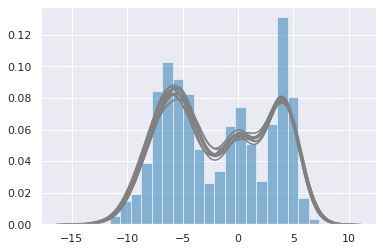
Note that the sampler is quite slow and convergence is poor. This is due to the need to sample over the discrete latent variable \(z\). We can improve convergence by marginalizing out \(z\).
Marginalization¶
Origina model
with pm.Model() as gmm1:
p = pm.Dirichlet('p', a=np.ones(k))
z = pm.Categorical('z', p=p, shape=data.shape[0])
μ = pm.Normal('μ', 0, 10, shape=k)
σ = pm.InverseGamma('τ', 1, 1, shape=k)
y = pm.Normal('y', mu=μ[z], sd=σ[z], observed=data)
[22]:
k = 3
with pm.Model() as gmm2:
p = pm.Dirichlet('p', a=np.ones(k))
μ = pm.Normal('μ', 0, 10, shape=k)
σ = pm.InverseGamma('τ', 1, 1, shape=k)
y = pm.NormalMixture('y', p, mu=μ, sd=σ, observed=data)
[23]:
with gmm2:
trace = pm.sample(n_init=10000, tune=1000)
Auto-assigning NUTS sampler...
Initializing NUTS using jitter+adapt_diag...
Multiprocess sampling (4 chains in 4 jobs)
NUTS: [τ, μ, p]
Sampling 4 chains, 0 divergences: 100%|██████████| 6000/6000 [00:08<00:00, 730.06draws/s]
The rhat statistic is larger than 1.4 for some parameters. The sampler did not converge.
The estimated number of effective samples is smaller than 200 for some parameters.
[24]:
pm.traceplot(trace, varnames=['p', 'μ', 'τ'])
pass
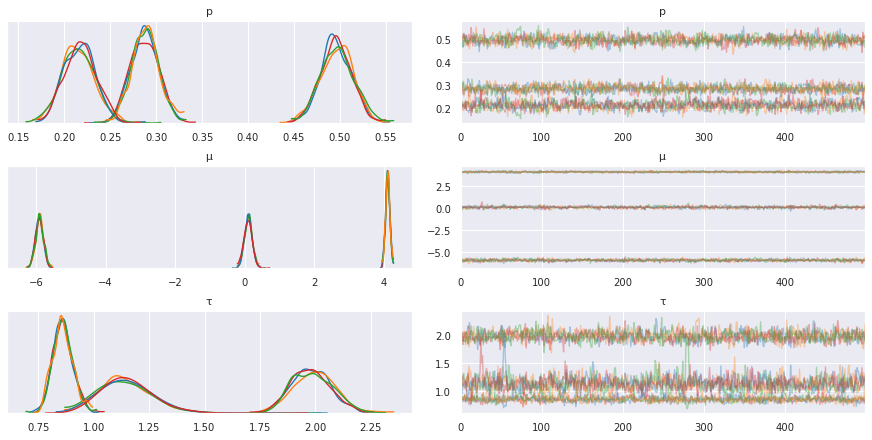
[25]:
with gmm2:
ppc = pm.sample_posterior_predictive(trace, samples=10)
plt.hist(data, bins=20, normed=True, alpha=0.5)
for i in range(10):
sns.distplot(ppc['y'][i], hist=False, color='grey')
100%|██████████| 10/10 [00:00<00:00, 19.86it/s]
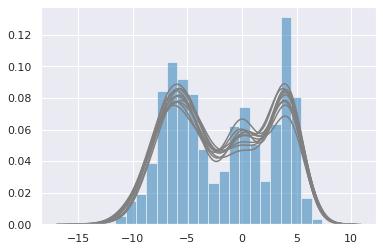
Dirichlet process¶
Samples from DP¶
[26]:
def sbp0(α, k, base=stats.norm(0,1)):
β = stats.beta.rvs(1, α, size=k)
w = β * np.r_[[1], (1 - β[:-1]).cumprod()]
x = base.rvs(size=k)
return w, x
[27]:
k = 50
xp = np.linspace(-3,3,100)
np.random.seed(123)
plt.figure(figsize=(12,3))
for i, α in enumerate([0.1, 1,10,100]):
plt.subplot(1, 4, i+1)
w, x = sbp0(α, k)
plt.vlines(x, 0, w)
plt.plot(xp, w.max()*stats.norm(0,1).pdf(xp))
plt.title('α = %.1f' % α)
plt.tight_layout()

DP mixture model¶
Generative process¶
[28]:
np.random.seed(123)
α = 1
k = 20
w, x = sbp0(α, k)
dist = stats.norm(x, 0.5)
[29]:
xp = np.transpose([np.linspace(-3,3,100)]*k)
plt.plot(xp[:,0], (w*dist.pdf(xp)).sum(1))
plt.plot(xp, w*dist.pdf(xp), c='grey', ls='--')
pass
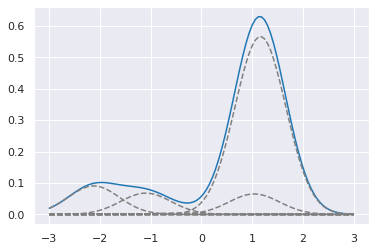
Fitting to data¶
[30]:
def sbp(α, k=20):
"""Stick breaking process geneerator."""
β = pm.Beta('β', 1, α, shape=k)
w = β * pm.math.concatenate([[1], (1 - β[:-1]).cumprod()])
return w
[31]:
with pm.Model() as dpgmm:
α = pm.Gamma('α', 1, 1)
p = pm.Deterministic('p', sbp(α))
μ = pm.Normal('μ',
np.linspace(data.min(), data.max(), k),
sd=10,
shape=k,
transform=pm.distributions.transforms.ordered)
σ = pm.InverseGamma('τ', 1, 1, shape=k)
y = pm.NormalMixture('y', p, mu=μ, sd=σ, observed=data)
[32]:
with dpgmm:
trace = pm.sample(n_init=10000, tune=1000)
Auto-assigning NUTS sampler...
Initializing NUTS using jitter+adapt_diag...
Multiprocess sampling (4 chains in 4 jobs)
NUTS: [τ, μ, β, α]
Sampling 4 chains, 924 divergences: 100%|██████████| 6000/6000 [17:11<00:00, 5.82draws/s]
There were 327 divergences after tuning. Increase `target_accept` or reparameterize.
There were 162 divergences after tuning. Increase `target_accept` or reparameterize.
There were 227 divergences after tuning. Increase `target_accept` or reparameterize.
There were 206 divergences after tuning. Increase `target_accept` or reparameterize.
The acceptance probability does not match the target. It is 0.6961217962136176, but should be close to 0.8. Try to increase the number of tuning steps.
The rhat statistic is larger than 1.2 for some parameters.
The estimated number of effective samples is smaller than 200 for some parameters.
[33]:
pm.traceplot(trace, varnames=['α'])
pass

Check that a truncation level of k=20 is sufficient.
[34]:
plt.stem(trace['p'].mean(axis=0))
plt.xticks(range(20))
pass

[ ]: